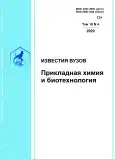Synthesis and using of 10-hydroxy-3,3,6,6-tetramethyl-9-(4-hydroxy-3-methoxyphenyl)-1,2,3,4,5,6,7,8,9,10-decahydroacridin-1,8-dion as acid base titration indicator
- Authors: Pyrko A.N.1
-
Affiliations:
- International Sakharov Environmental Institute of Belarusian State University
- Issue: Vol 10, No 4 (2020)
- Pages: 556-563
- Section: Chemical Sciences
- URL: https://bakhtiniada.ru/2227-2925/article/view/299579
- DOI: https://doi.org/10.21285/2227-2925-2020-10-4-556-563
- ID: 299579
Cite item
Full Text
Abstract
About the authors
A. N. Pyrko
International Sakharov Environmental Institute of Belarusian State University
Email: pyrko@yandex.ru
References
- Ozols Ya.Ya., Pyrko A.N., Lakhvich F.A., Vigante V.A., Dubure R.R., Dubur G.Ya., et al. Synthesis of decahydrophenanthridine-1,7-dione and hexahydroisoquinol-8-one derivatives in the reaction of 2-acetyl-2-cyclohexene-1-ones with conjugated enaminocarbonyl compounds // Chemistry of Heterocyclic Compounds. 1990. Vol. 26. Issue 1. P. 5862. https://di.org/10.1007/BF00506849
- Ozols Ya.Ya., Pyrko A.N., Vigante B.A., Dubu-re R.R., Dubur G.Ya. Synthesis of phenyl-substituted derivatives of decahydro-1,7-phenanthridinedione and hexahydro-8-isoquinolone // Chemistry of Heterocyclic Compounds. 1992. Vol. 28. Issue 5. P. 530-534. https://doi.org/10.1007/BF00475250
- Milkovic L., Vukovic T., Zarkovic N., Tatzber F., Bisenieks E., Kalme Z., et al. Antioxidative 1,4-di-hydropyridine derivatives modulate oxidative stress and growth of human osteoblast-like cells in vitro // Antioxidants. 2018. Vol. 123.Vol. 7. Issue 9. P. 1-23. https://di.org/10.3390/antiox7090123
- Mishnev A., Bisenieks E., Mandrika I., Pe-trovska R., Kalme Z., Bruverea I., et al. Crystal structure and metabolic activity of 4-(thien-2-yl)-2-methyl-5-oxo-1,4,5,6,7,8-hexahydrouinoline-3-car-boxylic acid ethoxycarbonylphenyl-methylester // Acta Crystallo-graphica. Section E. 2018. Vol. E74. P. 1577-1579. https://doi.org/10.1107/S2056989018014251
- Shekari F., Sadeghpour H., Javidnia K., Sa-so L., Nazari F., Firuzi O., et al. Cytotoxic and multidrug resistance reversal activities of novel 1,4-dihydropyridines against human cancer cells // European Journal of Pharmacology. 2015. Vol. 746. P. 233-244. https://doi.org/10.1016/j.ejphar.2014.10.058
- Velena A., Zarkovic N., Troselj K.G., Bisenieks E., Krauze A., Poikans J., et al. 1,4-Dihydropyridine derivatives: dihydronicotinamide analogues - model compounds targeting oxidative stress // Oxidative Medicine Celluar Longevity. 2016. Vol. 216. Article ID 1892412. https://doi.org/10.1155/2016/1892412
- Marjani A.P., Khalafy J., Chitan M., Mahmoodi S. Microwave-assisted synthesis of acri-dine-1,8(2H,5H)-diones via a one-pot, three component reaction // Iranian Journal of Chemistry and Chemical Engineerig. 2017. Vol. 36. Issue 2. P. 1-6.
- Nalini V., Girija R. Synthesis, characterization and biological studies of 9-aryl substituted acridinedione derivatives by Hantzsh condensation // International Journal of Current Reserch. 2013. Vol. 5. Issue 10. P. 3076-3081.
- Safaei-Ghomi J., Ghasemzadeh M.A., Zahedi S. ZnO nanoparticles: a highly efective and readily recyclable catalyst for the one-pot synthesis of 1,8-dioxo-decahydroacridine and dioxooctahydro-xanthene derivatives // Journal of the Mexican Chemical Society. 2013. Vol. 57. Issue 1. P. 1-7.
- Xia J.-J., Zhang K.-H. Synthesis of N-substituted acridinediones and polyhydroquinoline derivatives in refluxing water // Molecules. 2012. Vol. 17. Issue 5. P. 5339-5345. https://doi.org/10.3390/mo-lecules17055339
- Kalalawe V.G., Munde R.D., Kagne R.P., Niwadange S.N., Gutte R.D. Synthesis of acridine derivatives using ionic liquid as promoter // International Journal of Green and Herbal Chemistry. Sec. B. 2018. Vol. 7. Issue 2. P. 188-193. https://doi.org/10.24214/IJGHC/GC/7/2/18893
- Nakhi A., Srinivas P.V., Rahman M.S., Kishore R., Seerapu G.P.K., Kumar K.L., et al. Amberlite IR-120H catalyzed MCR: design, synthesis and crystal structure analysis of 1,8-dio-xodecahydroacridines as potential inhibitors of sir-tuins // Bioorganic and Medicinal Chemistry Letters. 2013. Vol. 23. Issue 6. P. 1828-1833. https://doi.org/10.1016/j.bmcl.2013.01.026
- Shchekotikhin Yu.M., Nikolaeva T.G., Shub G.M., Kriven’ko A.P. Synthesis and antibacterial activity of substituted 1,8-dioxodecahydroacridines // Pharmaceutical Chemistry Journal. 2001. Vol. 35. Issue 4. P. 206-211.
- Jezek J., Sebestic J., Hlavacek J. Biomedical applications of acridines: derivatives, syntheses, properties and biological activities a focus on neuro-degenerative diseases. Springer International Publishing AG. 2017. 236 p. https://doi.org/10.1007/978-3-319-63953-6
- Pesyan N.N., Akhteh N., Batmani H., Anil B., §ahin E. A facile and catalyst-free synthesis of hexahydroacridine-1,8(2H,5H )-dione and octahy-droacridin-10(1H )-yl)thiourea derivatives: Inter- and Intramolecular Aza-Michael addition // Heterocyclic Communications. 2020. Vol. 26. Issue 1. P. 26-32. https://doi.org/10.1515/hc-2020-0005
- Пырко A.H. Синтез и биологические испытания на пестицидную активность производных 1,2,3,4,5,6,7,8,9,10-декагидроакридиндиона-1,8 // Известия вузов. Прикладная химия и биотехнология. 2017. Т. 7. N 2. С. 16-20. https://doi.org/10.21285/2227-2925-2017-7-1-16-20
- Gutsulyak K.V., Manzhara V.S., Mel'nik M.V., Kalin T.I. Relationship between the structure and photostability of decahydroacridine derivatives // Journal of Applied Spectroscopy. 2005. Vol. 72. Issue 4. P. 488-494. https://doi.org/10.1007/s10812-005-0102-9
- Pyrko A.N. Synthesis and transformations of new 1,2,3,4,5,6,7,8,9,10- decahydroacridine-1,8-dione derivatives // Russian Journal of Organic Chemistry. 2008. Vol. 44. Issue 8. P. 1215-1224. https://doi.org/10.1134/S1070428008080198
- Beletskaya I.P., Kustov L.M. Catalysis as an important tool of green chemistry // Russian Chemical Reviews. 2010. Vol. 79. Issue 6. P. 493-515. https://doi.org/10.1070/RC2010v079n06ABEH004137
- Christian G.D., Dasgupta P.K., Schug K.A. Analytical chemistry; 7th revised ed. Washington: Wiley. 2013. 848 p.
- Shchekotikhin Yu.M.,Nickolaeva T.G. Characteristics of the dissociative ionization of 9-aryl(hetaryl)-3,3,6,6-tetra-methyldecahydroacridine-1,8-diones under the influence of electron impact // Chemistry of Heterocyclic Compounds. 2004. Vol. 40. Issue 8. P. 1031-1035. https://doi.org/10.1023/B:COHC.0000046693.85136.ac
Supplementary files









